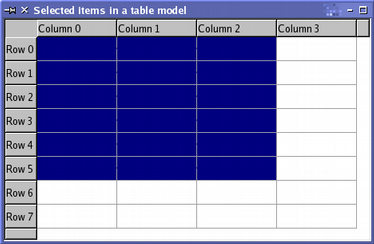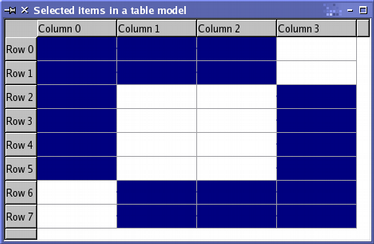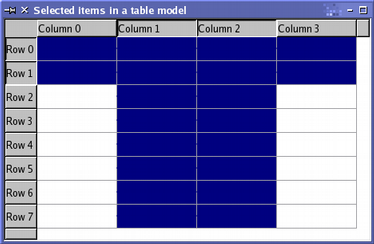概念
用于新的view类中的选择模型比Qt3中的模型有了很大的改进。它为基于model/view架构的选择提供了更为全面的描述。尽管对提供了的views来说,负责操纵选择的标准类已经足以应付,但是你也可以创建特定的选择模型来满足你特殊的需求。
关于在view被选择的数据项的信息保持在QItemSelectionModel类的实例中。它也为每个独立的model中的数据项维护model indexes信息,与任何views都关联关系。既然一个model可用于多个views,那么在多个views之间共享选择信息也是可以做到的,这使得多个views可以以一致的方式进行显示。
选择由多个选择范围组成。通过仅仅记录开始model indexes与结束model indexes,最大化地记录了可以选择的范围。非连续选择数据项由多个选择范围来描述。选择模型记录model indexes的集合来描述一个选择。最近选择的数据项被称为current selection。应用程序可以通过使用某种类型的选择命令来修改选择的效果。
在进行选择操作时,可以把QItemSelectionModel看成是model中所有数据项选择状态的一个记录。一旦建立一个选择模型,所有项的集合都可以选择,撤消选择,或者选择状态进行切换而不需要知道哪个数据项是否已经被选择过。所有被选择的项的indexes在任何时候都可以得到,通过信号槽机制可以通知别的组件发生的变化。
使用选择模型
标准view类提供了缺省的选择模型,它们可以在大次数程序中使用。一个view中的选择模型可以通过调用view的函数selectionModel()取得,也可以通过setSelectionModel()在多个views之间共享选择模型,因此总的来说构建一个新的模型一般情况不太必要。
通过给QItemSelection指定一个model,一对model indexes,可以创建一个选择。indexes的用法依赖于给定的model,这两个indexes被解释成选择的区块中的左上角项和右下角项。model中的项的选择服从于选择模型。
选择项
构建一个table model ,它有32个项,用一个table view进行显示:
TableModel *model = new TableModel(8, 4, &app);
QTableView *table = new QTableView(0);
table->setModel(model);
QItemSelectionModel *selectionModel = table->selectionModel();
QModelIndex topLeft;
QModelIndex bottomRight;
topLeft = model->index(0, 0, QModelIndex());
bottomRight = model->index(5, 2, QModelIndex());
QItemSelection selection(topLeft, bottomRight);
selectionModel->select(selection, QItemSelectionModel::Select);
结果如下:
读取选择状态
存储在选择模型中indexes可以用selectionIndexes()函数来读取。它返回一个未排序的model indexes列表,我们可以遍历它,如果我们知道他们关联于哪个model的话。
QModelIndexList indexes = selectionModel->selectedIndexes();
QModelIndex index;
foreach(index, indexes) {
QString text = QString("(%1,%2)").arg(index.row()).arg(index.column());
model->setData(index, text);
}
选择模型在选择发生变化时会发出信号。这用于通知别的组件包括整体与当前焦点项所发生的变化。我们可以连接selectionChanged()信号到一个槽,检查当信号产生时哪些项被选择或被取消选择。这个槽被调用时带有两个参数,它们都是QItemSelection对象,一个包含新被选择的项,另一个包含新近被取消选择的项。下面的代码演示了给新选择的项添加数据内容,新近被取消选择的项的内容被清空。
void MainWindow::updateSelection(const QItemSelection &selected,
const QItemSelection &deselected)
{
QModelIndex index;
QModelIndexList items = selected.indexes();
foreach (index, items) {
QString text = QString("(%1,%2)").arg(index.row()).arg(index.column());
model->setData(index, text);
}
items = deselected.indexes();
foreach (index, items)
model->setData(index, "");
}
也可以通过响应currentChanged()信号来跟踪当前焦点项.对应的槽就有两个接收参数,一个表示之前的焦点,另一个表示当前的焦点。
void MainWindow::changeCurrent(const QModelIndex ¤t,
const QModelIndex &previous)
{
statusBar()->showMessage(
tr("Moved from (%1,%2) to (%3,%4)")
.arg(previous.row()).arg(previous.column())
.arg(current.row()).arg(current.column()));
}
更新选择
选择指令是通过选择标志提供的,它被定义在QItemSelectionModel::SelectionFlag中。常用的有Select标记,Toggle标记,Deselect标记,Current标记,Clear标记,其意义一目了然。沿上面例子的结果执行以下代码:
QItemSelection toggleSelection;
topLeft = model->index(2, 1, QModelIndex());
bottomRight = model->index(7, 3, QModelIndex());
toggleSelection.select(topLeft, bottomRight);
selectionModel->select(toggleSelection, QItemSelectionModel::Toggle);
结果如下:
缺省情况下,选择指令只针对单个项(由model indexes指定)。然而,选择指令可以通过与另外标记的结合来改变整行和整列。举例来说,假如你只使用一个index来调用select(),但是用Select标记与Rows标记的组合,那么包括那个项的整行都将被选择。看以下示例:
QItemSelection columnSelection;
topLeft = model->index(0, 1, QModelIndex());
bottomRight = model->index(0, 2, QModelIndex());
columnSelection.select(topLeft, bottomRight);
selectionModel->select(columnSelection,
QItemSelectionModel::Select | QItemSelectionModel::Columns);
QItemSelection rowSelection;
topLeft = model->index(0, 0, QModelIndex());
bottomRight = model->index(1, 0, QModelIndex());
rowSelection.select(topLeft, bottomRight);
selectionModel->select(rowSelection,
QItemSelectionModel::Select | QItemSelectionModel::Rows);
结果如下
选择模型中所有项
为了选择model中的所有项,必须先得创建一个选择,它包括当前层次上的所有项:
QModelIndex topLeft = model->index(0, 0, parent);
QModelIndex bottomRight = model->index(model->rowCount(parent)-1,
model->columnCount(parent)-1, parent);
QItemSelection selection(topLeft, bottomRight);
selectionModel->select(selection, QItemSelectionModel::Select);
顶级index可以这样:
QModelIndex parent = QModelIndex();
对具有层次结构的model来说,可以使用hasChildren()函数来决定给定项是否是其它项的父项。